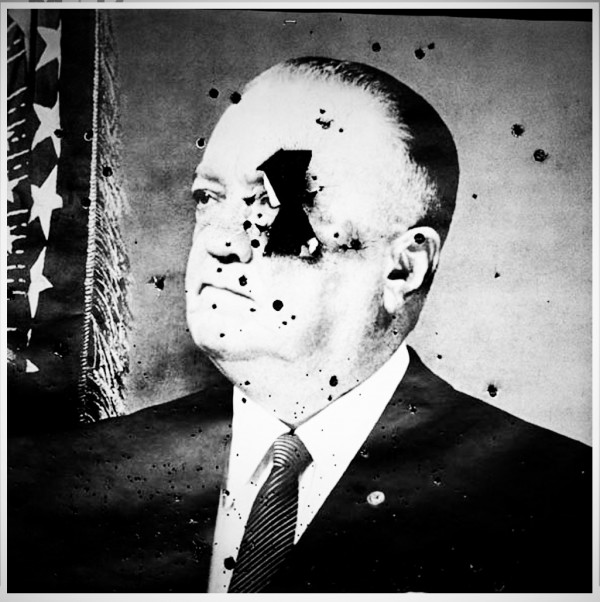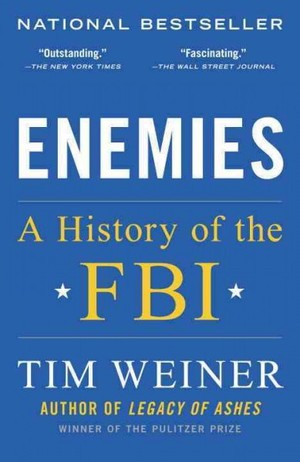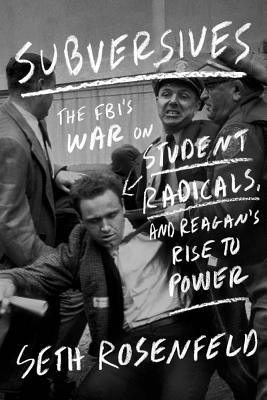
“J. Edgar Hoover Shotgun” c. 1960s gelatin silver print by Hunter S. Thompson
FRESH AIR
Four years after Pulitzer Prize-winning writer Tim Weiner published Legacy of Ashes, his detailed history of the CIA, he received a call from a lawyer in Washington, D.C. “He said, ‘I’ve just gotten my hands on a Freedom of Information Act request that’s 26 years old for [FBI Director] J. Edgar Hoover’s intelligence files. Would you like them?’ ” Weiner tells Fresh Air‘s Terry Gross. “And after a stunned silence, I said, ‘Yes, yes.’ ” Weiner went to the lawyer’s office and collected four boxes containing Hoover’s personal files on intelligence operations between 1945 and 1972. “Reading them is like looking over [Hoover’s] shoulder and listening to him talk out loud about the threats America faced, how the FBI was going to confront them,” he says. “Hoover had a terrible premonition after World War II that America was going to be attacked — that New York or Washington was going to be attacked by suicidal, kamikaze airplanes, by dirty bombs … and he never lost this fear.” Weiner’s book, Enemies: A History of the FBI, traces the history of the FBI’s secret intelligence operations, from the bureau’s creation in the early 20th century through its ongoing fight in the current war on terrorism. He explains how Hoover’s increasing concerns about communist threats against the United States led to the FBI’s secret intelligence operations against anyone deemed “subversive.”
Secrecy And The Red Raids
Weiner details how Hoover became increasingly worried about communist threats against the United States. Even before he became director of the FBI, Hoover was conducting secret intelligence operations against U.S. citizens he suspected  were anarchists, radical leftists or communists. After a series of anarchist bombings went off across the United States in 1919, Hoover sent five agents to infiltrate the newly formed Communist Party. “From that day forward, he planned a nationwide dragnet of mass arrests to round up subversives, round up communists, round up Russian aliens — as if he were quarantining carriers of typhoid,” Weiner says. On Jan. 1, 1920, Hoover sent out the arrest orders, and at least 6,000 people were arrested and detained throughout the country. “When the dust cleared, maybe 1 in 10 was found guilty of a deportable offense,” says Weiner. “Hoover denied — at the time and until his death — that he had been the intellectual author of the Red Raids.” Hoover, Attorney General Mitchell Palmer and Secretary of the Navy Franklin Delano Roosevelt all came under attack for their role in the raids. “It left a lifelong imprint on Hoover,” says Weiner. “If he was going to attack the enemies of the United States, better that it be done in secret and not under law. Because to convict people in court, you have to [reveal] your evidence, [but] when you’re doing secret intelligence operations, you just have to sabotage and subvert them and steal their secrets — you don’t have to produce evidence capable of discovery by the other side. That could embarrass you or get the case thrown out — because you had gone outside the law to enforce the law.” Hoover started amassing secret intelligence on “enemies of the United States” — a list that included terrorists, communists, spies — or anyone Hoover or the FBI had deemed subversive.
were anarchists, radical leftists or communists. After a series of anarchist bombings went off across the United States in 1919, Hoover sent five agents to infiltrate the newly formed Communist Party. “From that day forward, he planned a nationwide dragnet of mass arrests to round up subversives, round up communists, round up Russian aliens — as if he were quarantining carriers of typhoid,” Weiner says. On Jan. 1, 1920, Hoover sent out the arrest orders, and at least 6,000 people were arrested and detained throughout the country. “When the dust cleared, maybe 1 in 10 was found guilty of a deportable offense,” says Weiner. “Hoover denied — at the time and until his death — that he had been the intellectual author of the Red Raids.” Hoover, Attorney General Mitchell Palmer and Secretary of the Navy Franklin Delano Roosevelt all came under attack for their role in the raids. “It left a lifelong imprint on Hoover,” says Weiner. “If he was going to attack the enemies of the United States, better that it be done in secret and not under law. Because to convict people in court, you have to [reveal] your evidence, [but] when you’re doing secret intelligence operations, you just have to sabotage and subvert them and steal their secrets — you don’t have to produce evidence capable of discovery by the other side. That could embarrass you or get the case thrown out — because you had gone outside the law to enforce the law.” Hoover started amassing secret intelligence on “enemies of the United States” — a list that included terrorists, communists, spies — or anyone Hoover or the FBI had deemed subversive.
The Civil Rights Movement
Later on, anti-war protesters and civil rights leaders were added to Hoover’s list. “Hoover saw the civil rights movement from the 1950s onward and the anti-war movement from the 1960s onward, as presenting the greatest threats to the stability of the American government since the Civil War,” he says. “These people were enemies of the state, and in particular Martin Luther King [Jr.] was an enemy of the state. And Hoover aimed to watch over them. If they twitched in the wrong direction, the hammer would come down.” Hoover was intent on planting bugs around civil rights leaders — including King — because he thought communists had infiltrated the civil rights movement, says Weiner. Hoover had his intelligence chief bug King’s bedroom, and then sent the civil rights leader a copy of the sex recordings his intelligence chief had taken of King — along with an anonymous letter from the FBI. “It was a poison pen letter, it was a hate letter; it wasn’t from anyone in particular, but Martin Luther King and his wife would certainly know the source of the tapes, that it had to be the FBI,” says Weiner. “And the poison pen letter read: ‘King, look into your heart. The American people would know you for what you are — an evil, abnormal beast. There is only one way out for you. You better take it before your filthy, abnormal fraudulent self is bared to the nation.’ ” Weiner says King ignored the letter, even as the FBI tried diligently to defame him. “They were trying to get King knocked off from his perch as the Nobel Peace Prize recipient,” he says. “They sent [the tapes] to colleges to keep him off campus, they sent it around Washington.” It was Hoover, says Weiner, who decided that bugging King’s bedroom was necessary. “When it came down to bugging bedrooms, you had to be careful not to get caught, but there wasn’t anything to stop him,” says Weiner. “He decided up to a point … where the boundaries of the law [were] when it came to black bag jobs, break-ins, bugging, surveillance, the constitutionality of gathering secret intelligence on America’s enemies — both real and imagined. […] Hoover is the inventor of the modern American national security state. Every fingerprint file, every DNA record, every iris recorded through biometrics, every government dossier on every citizen and alien in this country owes its life to him. We live in his shadow, though he’s been gone for 40 years.

![]() FRESH AIR: In 1964, students at the University of California, Berkeley, formed a protest movement to repeal a campus rule banning students from engaging in political activities. Then-FBI Director J. Edgar Hoover suspected the free speech movement to be evidence of a Communist plot to disrupt U.S. campuses. He “had long been concerned about alleged subversion within the education field,” journalist Seth Rosenfeld tells Fresh Air’s Terry Gross. So Hoover ordered his agents to look into whether the movement was subversive. When they returned and said that it wasn’t, Hoover not only continued to investigate the group but also used “dirty tricks to stifle dissent on the campus,” according to Rosenfeld. Rosenfeld’s new book, Subversives: The FBI’s War on Student Radicals and Reagan’s Rise to Power, details how the FBI employed fake reporters to plant ideas and shape public opinion about the student movement; how they planted stories with real reporters; and how they even managed — with the help of then-Gov. Ronald Reagan — to get the UC Berkeley’s President Clark Kerr fired. To research the book, Rosenfeld pored over 300,000 pages of records obtained over 30 years from five lengthy Freedom of Information Act lawsuits against the FBI. MORE
FRESH AIR: In 1964, students at the University of California, Berkeley, formed a protest movement to repeal a campus rule banning students from engaging in political activities. Then-FBI Director J. Edgar Hoover suspected the free speech movement to be evidence of a Communist plot to disrupt U.S. campuses. He “had long been concerned about alleged subversion within the education field,” journalist Seth Rosenfeld tells Fresh Air’s Terry Gross. So Hoover ordered his agents to look into whether the movement was subversive. When they returned and said that it wasn’t, Hoover not only continued to investigate the group but also used “dirty tricks to stifle dissent on the campus,” according to Rosenfeld. Rosenfeld’s new book, Subversives: The FBI’s War on Student Radicals and Reagan’s Rise to Power, details how the FBI employed fake reporters to plant ideas and shape public opinion about the student movement; how they planted stories with real reporters; and how they even managed — with the help of then-Gov. Ronald Reagan — to get the UC Berkeley’s President Clark Kerr fired. To research the book, Rosenfeld pored over 300,000 pages of records obtained over 30 years from five lengthy Freedom of Information Act lawsuits against the FBI. MORE
TRUTH DIG: The protests at UC Berkeley in the 1960s—and the conservative backlash that followed them—helped propel Ronald Reagan to the governor’s mansion and then to the White House. Since then, a generation of conservative adoration has transformed Reagan into the embodiment of Republican virtue. Seth Rosenfeld’s new book, “Subversives: The FBI’s War on Student Radicals, and Reagan’s Rise to Power,” challenges that portrait in a unique and compelling way. Drawing on FBI files and scores of interviews, Rosenfeld shows how Reagan formed a partnership with the FBI that began in the 1940s and lasted at least until J. Edgar Hoover’s death in 1972. During that time, Reagan, Hoover and their allies sabotaged the careers of law-abiding citizens, defended reckless police violence and exploited an appalling double standard in the political use of FBI intelligence.
In 1969, riot police shot dozens of Berkeley protesters and bystanders with birdshot and buckshot, permanently blinding one man and killing student James Rector. Reagan told an Orange County audience, “The police didn’t kill the young man. He was killed by the first college administrator who said some time ago that it was all right to break the laws in the name of dissent.” It  was a transparent attempt to blame others for the “bloodbath” he had welcomed in an earlier public remark. Even more outrageously, Reagan aide Edwin Meese told journalist (and now Truthdig Editor-in-Chief) Robert Scheer, “James Rector deserved to die,” an opinion he repeated to Rosenfeld. Some deputies were sanctioned for the shootings but none were convicted, and federal charges were dropped after Reagan pressed U.S. Attorney General John Mitchell. The Reagan administration’s policy—“Obey the rules or get out”—seemed to apply only to university students.
was a transparent attempt to blame others for the “bloodbath” he had welcomed in an earlier public remark. Even more outrageously, Reagan aide Edwin Meese told journalist (and now Truthdig Editor-in-Chief) Robert Scheer, “James Rector deserved to die,” an opinion he repeated to Rosenfeld. Some deputies were sanctioned for the shootings but none were convicted, and federal charges were dropped after Reagan pressed U.S. Attorney General John Mitchell. The Reagan administration’s policy—“Obey the rules or get out”—seemed to apply only to university students.
With Reagan, of course, the rest is history. In one of his first presidential acts, he pardoned high-ranking FBI officials who had authorized warrantless break-ins at the homes of relatives and friends of Weather Underground fugitives. In announcing the pardons, Reagan said, “The record demonstrates that they acted not with criminal intent but in the belief that they had grants of authority reaching to the highest levels of government.” One of the prosecutors flatly refuted that claim. “That assertion is false,” Francis J. Martin wrote in a New York Times opinion piece. “The FBI’s own documents attest to the fact that it is false. After an eight-week trial, 12 jurors unanimously found it to be false.”
One of the book’s most interesting stories concerns the FBI’s efforts to withhold information about its assistance to Reagan. In an appendix, Rosenfeld details the lawsuits he filed and won over three decades to acquire the relevant FBI documents. The heroes of this saga include San Francisco federal Judge Marilyn Patel, who ruled that “Information regarding acts taken to protect or promote Reagan’s political career, or acts done as political favors to Reagan[,], serve no legitimate law enforcement purpose.” Having studied some 50,000 pages of FBI records, Rosenfeld reaches the following conclusion:
These documents show that during the Cold War, FBI officials sought to change the course of history by secretly interceding in events, manipulating public opinion, and taking sides in partisan politics. The bureau’s efforts, decades later, to improperly withhold information about those activities under the [Freedom of Information Act] are, in effect, another attempt to shape history, this time by obscuring the past. MORE
RELATED: In the early 1960s Reagan opposed certain civil rights legislation, saying that “if an individual wants to discriminate against Negroes or others in selling or renting his house, it is his right to do so.”[67] In his rationale, he cited his opposition to government intrusion into personal freedoms, as opposed to racism; he strongly denied having racist motives and later reversed his opposition to voting rights and fair housing laws.[68] When legislation that would become Medicare was introduced in 1961, Reagan created a recording for the American Medical Association warning that such legislation would mean the end of freedom in America. Reagan said that if his listeners did not write letters to prevent it, “we will awake to find that we have socialism. And if you don’t do this, and if I don’t do it, one of these days, you and I are going to spend our sunset years telling our children, and our children’s children, what it once was like in America when men were free.”[69][70][71] He also joined the National Rifle Association and would become a lifetime member.[72]
